Predicting Future Land Use Utilizing Economic and Land Surface Parameters with ANN and Markov Chain Models
Abstract
:1. Introduction
2. Materials and Methods
2.1. Study Area
2.2. Data and Software Used
2.3. Preprocessing of Data
2.4. Classification
2.4.1. Maximum Likelihood Classifier
2.4.2. Support Vector Machine Classifier
2.5. Accuracy Assessment
2.6. CA–Markov Model for Land Use Change Prediction
3. Results
3.1. Predicting the Best Classifier
3.2. Land Use and Land Cover Change 1990–2020
3.3. Land Use Transformation
3.3.1. Barren Land to Other Classes
3.3.2. Vegetation to Other Classes
3.3.3. Agriculture to Other Classes
3.3.4. Waterbody to Other Classes
3.3.5. Wetland to Other Classes
3.3.6. Build Up to Other Classes
3.3.7. Fallow Land to Other Classes
3.4. Variables Map
3.5. Predicting of Future LULC
3.6. Model Validation
4. Discussion
Study Limitations and Future Work
5. Conclusions
Author Contributions
Funding
Data Availability Statement
Acknowledgments
Conflicts of Interest
Appendix A

| Area of MLC Classified LULC Classes | |||||||||
|---|---|---|---|---|---|---|---|---|---|
| 1990 LULC | 2000 LULC | 2010 LULC | 2020 LULC | ||||||
| Classes | Area sq km | Area (%) | Area sq km | Area (%) | Area sq km | Area (%) | Area sq km | Area (%) | |
| 1 | Barren land | 29.5 | 0.87% | 27.5 | 0.81% | 19.4 | 0.57% | 21.7 | 0.64% |
| 2 | Vegetation | 215.3 | 6.30% | 276.1 | 8.10% | 178 | 5.25% | 168.7 | 4.90% |
| 3 | Agriculture | 2115.7 | 62% | 2477.6 | 73.10% | 2587 | 76.40% | 2783.4 | 82.20% |
| 4 | Waterbody | 7.4 | 0.21% | 6.1 | 0.18% | 7.6 | 0.22% | 6.3 | 0.18% |
| 5 | Wetland | 10.7 | 0.31% | 17.7 | 0.55% | 19.2 | 0.56% | 19.1 | 0.58% |
| 6 | Build up | 107 | 3.10% | 114.9 | 3.30% | 122.4 | 3.60% | 224.8 | 6.60% |
| 7 | Fallow land | 899.4 | 26.50% | 464.5 | 13.70% | 451.7 | 13.30% | 161 | 4.70% |
References
- Bansal, V.; Jagadisan, S.; Sen, J. Water Urbanism and Multifunctional Landscapes: Case of Adyar River, Chennai, and Ganga River, Varanasi, India. In Urban Ecology and Global Climate Change; John Wiley & Sons, Inc.: Hoboken, NJ, USA, 2022; pp. 85–103. [Google Scholar]
- Forster, T.; Escudero, A.G. City Regions as Landscapes for People Food and Nature; EcoAgriculture Partners: Washington, DC, USA, 2014; p. 62. [Google Scholar]
- Soni, S.; Kler, T.K.; Javed, M. Emerging threat of urbanization to ponds and avian fauna in Punjab, India. J. Entomol. Zool. Stud. 2019, 7, 1310–1315. [Google Scholar]
- Kumar, S.; Kler, T.K. Avian diversity at Beas River conservation reserve under urbanization and intensive agriculture in Punjab, India. In Biological Diversity: Current Status and Conservation Policies; Agriculture and Environmental Science Academy: Haridwar, India, 2021; p. 1. [Google Scholar]
- Meraj, G.; Kanga, S.; Ambadkar, A.; Kumar, P.; Singh, S.K.; Farooq, M.; Johnson, B.A.; Rai, A.; Sahu, N. Assessing the Yield of Wheat Using Satellite Remote Sensing-Based Machine Learning Algorithms and Simulation Modeling. Remote Sens. 2022, 14, 3005. [Google Scholar] [CrossRef]
- Bhagat, R.B.; Mohanty, S. Emerging pattern of urbanization and the contribution of migration in urban growth in India. Asian Popul. Stud. 2009, 5, 5–20. [Google Scholar]
- Ratnam, R.; Kaur, R. Spatially Contextualizing Rural Land Transformation in Peri-Urban Area: A case of Jalandhar City, Punjab (India). Int. J. Geoinform. 2023, 19, 11–24. [Google Scholar]
- Gupta, S.K.; Pandey, A.C. Change detection of landscape connectivity arisen by forest transformation in 9. Hazaribagh wildlife sanctuary, Jharkhand (India). Spat. Inf. Res. 2020, 28, 391–404. [Google Scholar]
- Bibri, S.E. Advances in the Leading Paradigms of Urbanism and Their Amalgamation: Compact Cities, Eco–Cities, and Data–Driven Smart Cities; Springer: Berlin/Heidelberg, Germany, 2020. [Google Scholar]
- Kumar, A.; Ekka, P.; Patra, S.; Kumar, G.; Kishore, B.S.; Kumar, R.; Saikia, P. Geospatial Perspectives of Sustainable Forest Management to Enhance Ecosystem Services and Livelihood Security. In Advances in Remote Sensing for Forest Monitoring; John Wiley & Sons, Inc.: Hoboken, NJ, USA, 2022; pp. 10–42. [Google Scholar]
- Bagheri, M.; Zaiton Ibrahim, Z.; Mansor, S.; Manaf, L.A.; Akhir, M.F.; Talaat, W.I.A.W.; Beiranvand Pour, A. Land-use suitability assessment using Delphi and analytical hierarchy process (D-AHP) hybrid model for coastal city management: Kuala Terengganu, Peninsular Malaysia. ISPRS Int. J. Geo-Inf. 2021, 10, 621. [Google Scholar]
- von Staden, L.; Lötter, M.C.; Holness, S.; Lombard, A.T. An evaluation of the effectiveness of Critical Biodiversity Areas, identified through a systematic conservation planning process, to reduce biodiversity loss outside protected areas in South Africa. Land Use Policy 2022, 115, 106044. [Google Scholar]
- Das, D.K. Factors and strategies for environmental justice in organized urban green space development. Urban Plan. 2022, 7, 160–173. [Google Scholar]
- Yalcinkaya, S.; Kirtiloglu, O.S. Application of a geographic information system-based fuzzy analytic hierarchy process model to locate potential municipal solid waste incineration plant sites: A case study of Izmir Metropolitan Municipality. Waste Manag. Res. 2021, 39, 174–184. [Google Scholar]
- Little, D.L.; Dils, R.E.; Gray, J. Environment, Land Use, and Land Management. In Renewable Natural Resources: A Management Handbook for the 1980s; Routledge: Oxfordshire, UK, 2019; pp. 156–174. [Google Scholar]
- Meraj, G.; Kanga, S.; Kranjčić, N.; Đurin, B.; Singh, S.K. Role of Natural Capital Economics for Sustainable Management of Earth Resources. Earth 2021, 2, 622–634. [Google Scholar] [CrossRef]
- Giannetti, B.F.; Agostinho, F.; Eras, J.C.; Yang, Z.; Almeida CM, V.B. Cleaner production for achieving the sustainable development goals. J. Clean. Prod. 2020, 271, 122127. [Google Scholar]
- Sgroi, F. Forest resources and sustainable tourism, a combination for the resilience of the landscape and development of mountain areas. Sci. Total Environ. 2020, 736, 139539. [Google Scholar] [PubMed]
- Khan, I.; Zakari, A.; Zhang, J.; Dagar, V.; Singh, S. A study of trilemma energy balance, clean energy transitions, and economic expansion in the midst of environmental sustainability: New insights from three trilemma leadership. Energy 2022, 248, 123619. [Google Scholar] [CrossRef]
- Hill, R.; Adem, Ç.; Alangui, W.V.; Molnár, Z.; Aumeeruddy-Thomas, Y.; Bridgewater, P.; Tengö, M.; Thaman, R.; Yao, C.Y.A.; Berkes, F.; et al. Working with indigenous, local and scientific knowledge in assessments of nature and nature’s linkages with people. Curr. Opin. Environ. Sustain. 2020, 43, 8–20. [Google Scholar]
- Meraj, G.; Singh, S.K.; Kanga, S.; Islam, N. Modeling on comparison of ecosystem services concepts, tools, methods and their ecological-economic implications: A review. Model. Earth Syst. Environ. 2022, 8, 15–34. [Google Scholar] [CrossRef]
- Sanson, A.V.; Burke, S.E. Climate change and children: An issue of intergenerational justice. In Children Peace: From Research to Action; Springer: Berlin/Heidelberg, Germany, 2020; pp. 343–362. [Google Scholar]
- Ćurčić, N.; Mirković Svitlica, A.; Brankov, J.; Bjeljac, Ž.; Pavlović, S.; Jandžiković, B. The role of rural tourism in strengthening the sustainability of rural areas: The case of Zlakusa village. Sustainability 2021, 13, 6747. [Google Scholar] [CrossRef]
- Farooq, M.; Mushtaq, F.; Meraj, G.; Singh, S.K.; Kanga, S.; Gupta, A.; Kumar, P.; Singh, D.; Avtar, R. Strategic Slum Upgrading and Redevelopment Action Plan for Jammu City. Resources 2022, 11, 120. [Google Scholar] [CrossRef]
- Cobos Mora, S.L.; Solano Peláez, J.L. Sanitary landfill site selection using multi-criteria decision analysis and analytical hierarchy process: A case study in Azuay province, Ecuador. Waste Manag. Res. 2020, 38, 1129–1141. [Google Scholar] [CrossRef] [PubMed]
- Cradock-Henry, N.A.; Blackett, P.; Hall, M.; Johnstone, P.; Teixeira, E.; Wreford, A. Climate adaptation pathways for agriculture: Insights from a participatory process. Environ. Sci. Policy 2020, 107, 66–79. [Google Scholar]
- Kanga, S.; Meraj, G.; Johnson, B.A.; Singh, S.K.; PV, M.N.; Farooq, M.; Kumar, P.; Marazi, A.; Sahu, N. Understanding the Linkage between Urban Growth and Land Surface Temperature—A Case Study of Bangalore City, India. Remote Sens. 2022, 14, 4241. [Google Scholar] [CrossRef]
- Meli, P.; Rey-Benayas, J.M.; Brancalion, P.H. Balancing land sharing and sparing approaches to promote forest and landscape restoration in agricultural landscapes: Land approaches for forest landscape restoration. Perspect. Ecol. Conserv. 2019, 17, 201–205. [Google Scholar]
- Paul, P.; Aithal, P.S.; Bhimali, A.; Kalishankar, T.; Saavedra, M.R.; Aremu, P.S.B. Geo information systems and remote sensing: Applications in environmental systems and management. Int. J. Manag. Technol. Soc. Sci. (IJMTS) 2020, 5, 11–18. [Google Scholar]
- Yasir, M.; Hui, S.; Binghu, H.; Rahman, S.U. Coastline extraction and land use change analysis using remote sensing (RS) and geographic information system (GIS) technology–A review of the literature. Rev. Environ. Health 2020, 35, 453–460. [Google Scholar] [CrossRef] [PubMed]
- Ghalehteimouri, K.J.; Shamsoddini, A.; Mousavi, M.N.; Ros, F.B.C.; Khedmatzadeh, A. Predicting spatial and decadal of land use and land cover change using integrated cellular automata Markov chain model-based scenarios (2019–2049) Zarriné-Rūd River Basin in Iran. Environ. Chall. 2022, 6, 100399. [Google Scholar] [CrossRef]
- Samani, S.; Vadiati, M.; Delkash, M.; Bonakdari, H. A hybrid wavelet–machine learning model for qanat water flow prediction. Acta Geophys. 2022, 71, 1895–1913. [Google Scholar] [CrossRef]
- Yuh, Y.G.; Tracz, W.; Matthews, H.D.; Turner, S.E. Application of machine learning approaches for land cover monitoring in northern Cameroon. Ecol. Inform. 2023, 74, 101955. [Google Scholar] [CrossRef]
- Singh, S.; Singh, S.K.; Prajapat, D.K.; Pandey, V.; Kanga, S.; Kumar, P.; Meraj, G. Assessing the Impact of the 2004 Indian Ocean Tsunami on South Andaman’s Coastal Shoreline: A Geospatial Analysis of Erosion and Accretion Patterns. J. Mar. Sci. Eng. 2023, 11, 1134. [Google Scholar] [CrossRef]
- Wu, H.; Li, Z.; Clarke, K.C.; Shi, W.; Fang, L.; Lin, A.; Zhou, J. Examining the sensitivity of spatial scale in cellular automata Markov chain simulation of land use change. Int. J. Geogr. Inf. Sci. 2019, 33, 1040–1061. [Google Scholar] [CrossRef]
- Leigh, N.G.; Lee, H. Sustainable and Resilient Urban Water Systems: The Role of Decentralization and Planning. Sustainability 2019, 11, 918. [Google Scholar] [CrossRef]
- Lu, Y.; Wu, P.; Ma, X.; Li, X. Detection and prediction of land use/land cover change using spatiotemporal data fusion and the Cellular Automata–Markov model. Environ. Monit. Assess. 2019, 191, 68. [Google Scholar] [CrossRef]
- Motlagh, Z.K.; Lotfi, A.; Pourmanafi, S.; Ahmadizadeh, S.; Soffianian, A. Spatial modeling of land-use change in a rapidly urbanizing landscape in central Iran: Integration of remote sensing, CA-Markov, and landscape metrics. Environ. Monit. Assess. 2020, 192, 695. [Google Scholar] [CrossRef] [PubMed]
- Debnath, J.; Sahariah, D.; Lahon, D.; Nath, N.; Chand, K.; Meraj, G.; Singh, S.K. Geospatial modeling to assess the past and future land use-land cover changes in the Brahmaputra Valley, NE India, for sustainable land resource management. Environ. Sci. Pollut. Res. 2022, 1–24. [Google Scholar] [CrossRef] [PubMed]
- US Geological Survey (USGS). Available online: https://www.usgs.gov/centers/eros/science/usgs-erosarchive-digital-elevation-shuttle-radar-topography-mission-srtm-1-arc?qt-science_center_objects=0#qtscience_center_objects (accessed on 31 December 2022).
- Chicco, D.; Jurman, G. The advantages of the Matthews correlation coefficient (MCC) over F1 score and accuracy in binary classification evaluation. BMC Genom. 2020, 21, 6. [Google Scholar] [CrossRef] [PubMed]
- Richards, J. Remote Sensing Digital Image Analysis; Springer: Berlin/Heidelberg, Germany, 1999; 240p. [Google Scholar]
- Rathore, D.; Singh, A.; Dahiya, D.; Nigam PS, N. Sustainability of biohydrogen as fuel: Present scenario and future perspective. AIMS Energy 2019, 7, 1–19. [Google Scholar] [CrossRef]
- Sharma, D.; Rao, K.; Ramanathan, A. A Systematic Review on the Impact of Urbanization and Industrialization on Indian Coastal Mangrove Ecosystem. In Coastal Ecosystems. Coastal Research Library; Madhav, S., Nazneen, S., Singh, P., Eds.; Springer: Cham, Switzerland, 2022; Volume 38. [Google Scholar] [CrossRef]
- Kanga, S.; Singh, S.K.; Meraj, G.; Kumar, A.; Parveen, R.; Kranjčić, N.; Đurin, B. Assessment of the Impact of Urbanization on Geoenvironmental Settings Using Geospatial Techniques: A Study of Panchkula District, Haryana. Geographies 2022, 2, 1–10. [Google Scholar] [CrossRef]
- Pokhariya, H.S.; Singh, D.P.; Prakash, R. Investigating the impacts of urbanization on different land cover classes and land surface temperature using GIS and RS techniques. Int. J. Syst. Assur. Eng. Manag. 2022, 13 (Suppl. 2), 961–969. [Google Scholar] [CrossRef]
- Raj. Assessment of land management practices impact on soil and water resources using swat model: A case of bara micro-watershed of ken catchment, Madhya pradesh, India. Sustain. Water Resour. Manag. 2020, 6, 87. [Google Scholar] [CrossRef]
- Chang, C.-C.; Lin, C.-J. LIBSVM: A library for support vector machines. ACM Trans. Intell. Syst. Technol. 2011, 2, 1–27. [Google Scholar] [CrossRef]
- McHugh, M.L. Interrater reliability: The kappa statistic. Biochem. Medica 2012, 22, 276–282. [Google Scholar] [CrossRef]
- Chand, R. Transforming agriculture for challenges of 21st century. Think. India J. 2019, 22, 26. [Google Scholar]
- Central Ground Water pollution Control Board, CGWB. 2017. Available online: http://cgwb.gov.in/ (accessed on 30 October 2021).
- Vijay, V.; Armsworth, P.R. Pervasive cropland in protected areas highlight trade-offs between conservation and food security. Proc. Natl. Acad. Sci. USA 2021, 118, e2010121118. [Google Scholar] [CrossRef] [PubMed]
- Bera, A.; Meraj, G.; Kanga, S.; Farooq, M.; Singh, S.K.; Sahu, N.; Kumar, P. Vulnerability and Risk Assessment to Climate Change in Sagar Island, India. Water 2022, 14, 823. [Google Scholar] [CrossRef]
- Arifeen, H.M.; Phoungthong, K.; Mostafaeipour, A.; Yuangyai, N.; Yuangyai, C.; Techato, K.; Jutidamrongphan, W. Determine the land-use land-cover changes, urban expansion and their driving factors for sustainable development in Gazipur Bangladesh. Atmosphere 2021, 12, 1353. [Google Scholar] [CrossRef]
- Yacamán Ochoa, C.; Ferrer Jiménez, D.; Mata Olmo, R. Green infrastructure planning in metropolitan regions to improve the connectivity of agricultural landscapes and food security. Land 2020, 9, 414. [Google Scholar]
- Bashir, O.; Bangroo, S.A.; Guo, W.; Meraj, G.; Ayele, G.T.; Naikoo, N.B.; Shafai, S.; Singh, P.; Muslim, M.; Taddese, H.; et al. Simulating Spatiotemporal Changes in Land Use and Land Cover of the North-Western Himalayan Region Using Markov Chain Analysis. Land 2022, 11, 2276. [Google Scholar] [CrossRef]
- Wang, J.; Bretz, M.; Dewan MA, A.; Delavar, M.A. Machine learning in modelling land-use and land cover-change (LULCC): Current status, challenges and prospects. Sci. Total Environ. 2022, 822, 153559. [Google Scholar] [CrossRef]
- Liu, M.; Liu, Y.; Ye, Y. Nonlinear effects of built environment features on metro ridership: An integrated exploration with machine learning considering spatial heterogeneity. Sustain. Cities Soc. 2023, 95, 104613. [Google Scholar] [CrossRef]
- Sajan, B.; Mishra, V.N.; Kanga, S.; Meraj, G.; Singh, S.K.; Kumar, P. Cellular Automata-Based Artificial Neural Network Model for Assessing Past, Present, and Future Land Use/Land Cover Dynamics. Agronomy 2022, 12, 2772. [Google Scholar] [CrossRef]
- Braun, A.C. More accurate less meaningful? A critical physical geographer’s reflection on interpreting remote sensing land-use analyses. Prog. Phys. Geogr. Earth Environ. 2021, 45, 706–735. [Google Scholar]
- Rimal, B.; Keshtkar, H.; Sharma, R.; Stork, N.; Rijal, S.; Kunwar, R. Simulating urban expansion in a rapidly changing landscape in eastern Tarai, Nepal. Environ. Monit. Assess. 2019, 191, 255. [Google Scholar] [CrossRef]
- Choudhury, U.; Singh, S.K.; Kumar, A.; Meraj, G.; Kumar, P.; Kanga, S. Assessing Land Use/Land Cover Changes and Urban Heat Island Intensification: A Case Study of Kamrup Metropolitan District, Northeast India (2000–2032). Earth 2023, 4, 503–521. [Google Scholar] [CrossRef]
- Saltelli, A.; Ratto, M.; Andres, T.; Campolongo, F.; Cariboni, J.; Gatelli, D.; Saisana, M.; Tarantola, S. Optimal information networks: Application for data-driven integrated health in populations. Sci. Adv. 2004, 4, e1701088. [Google Scholar] [CrossRef]
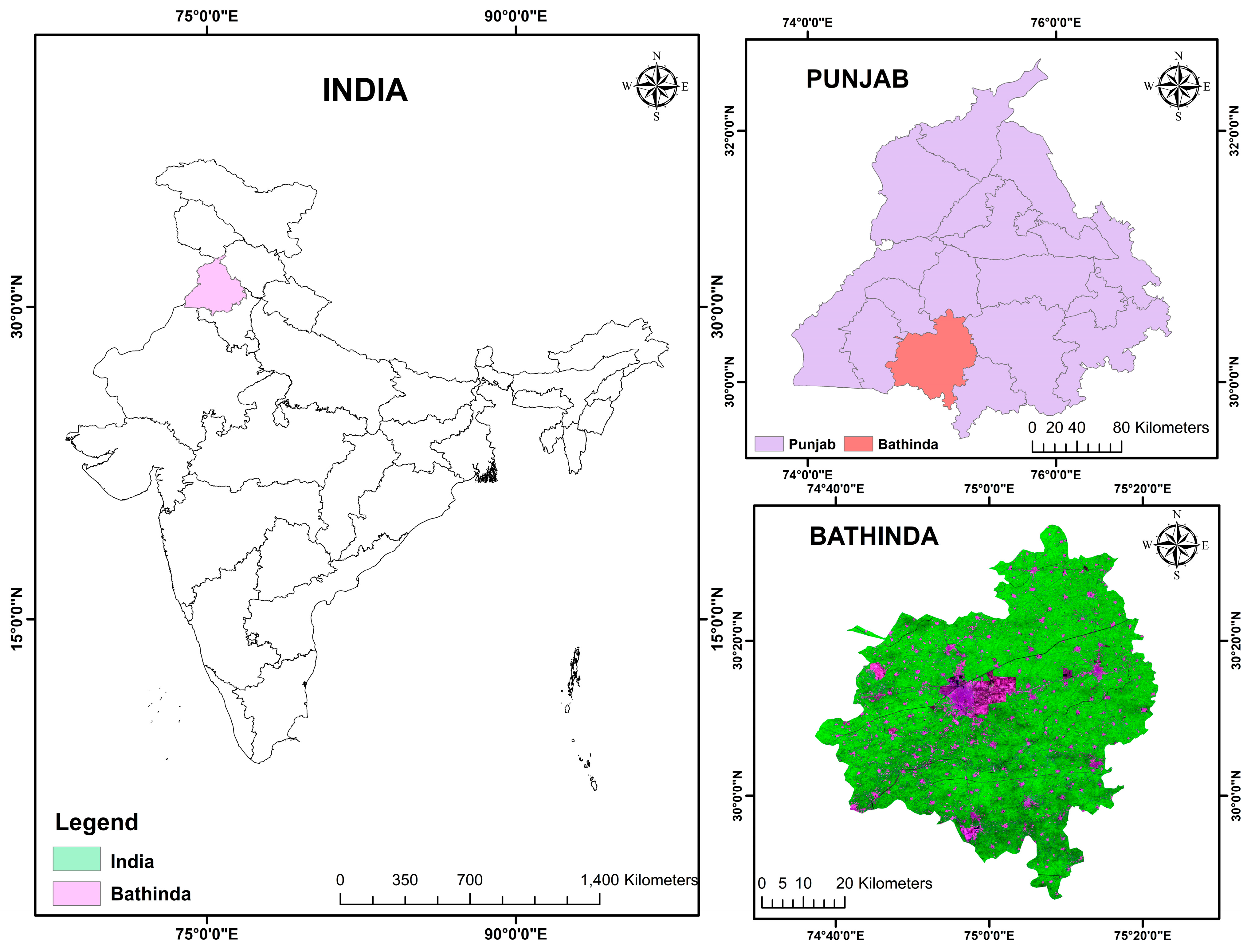
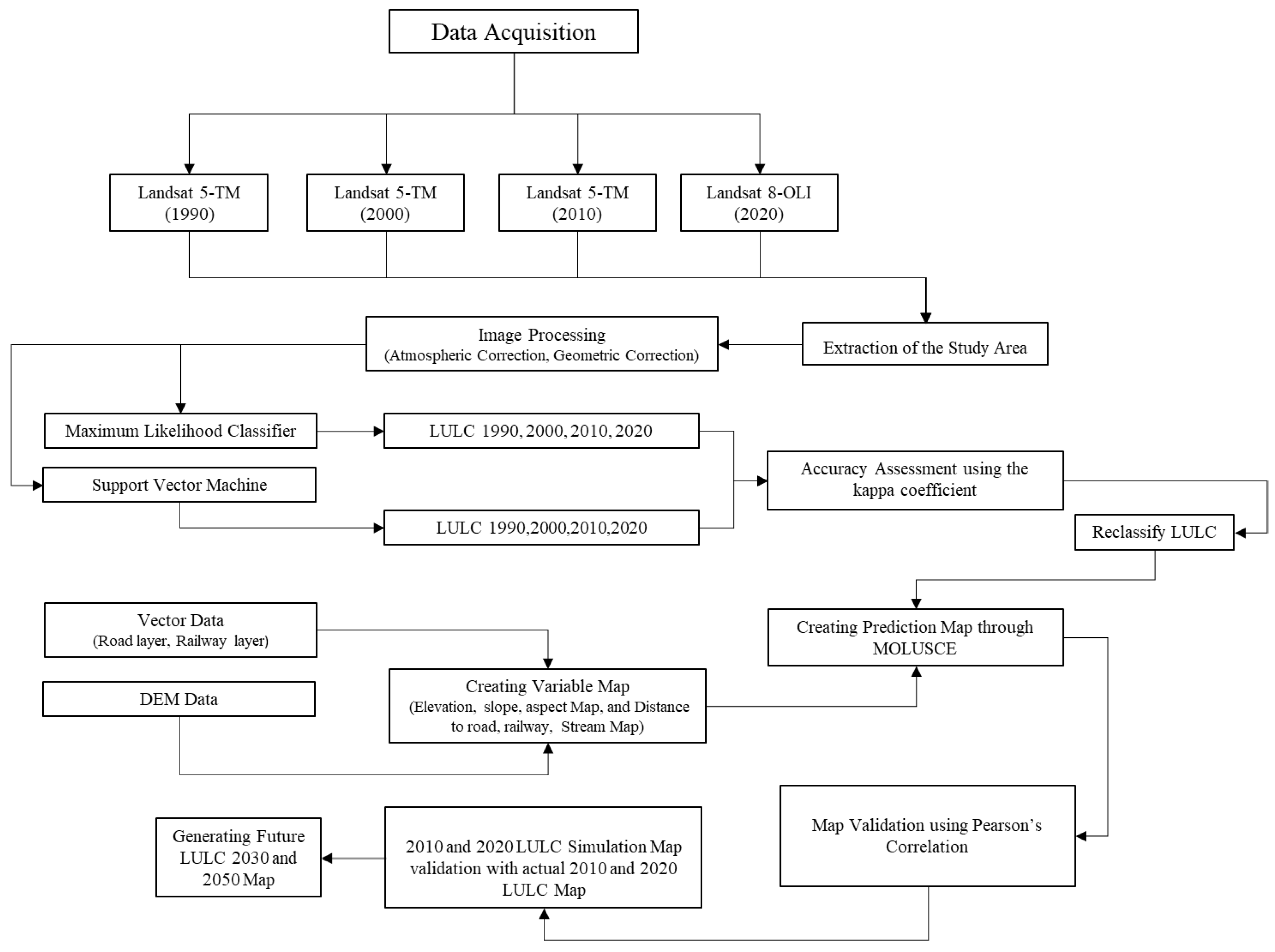
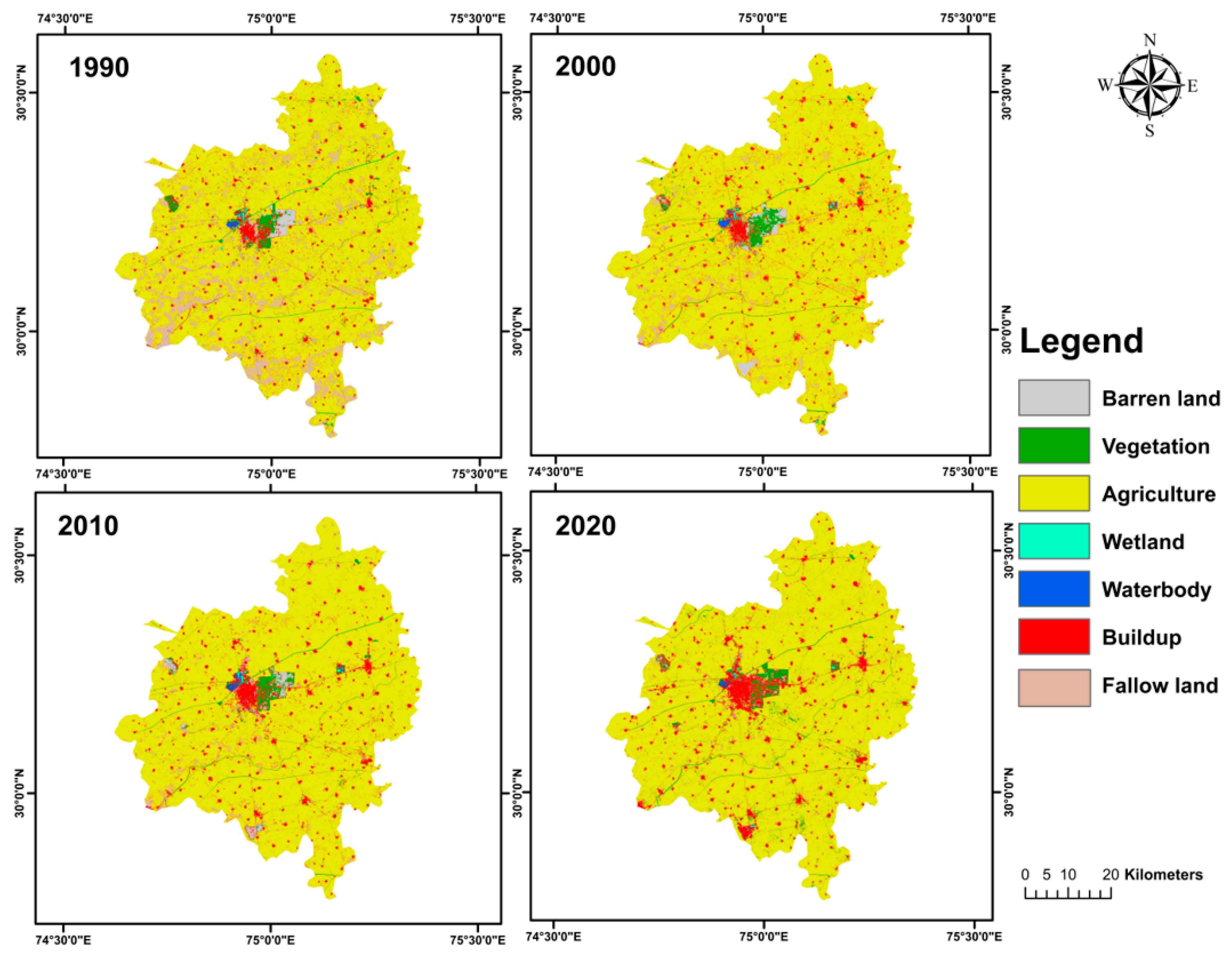
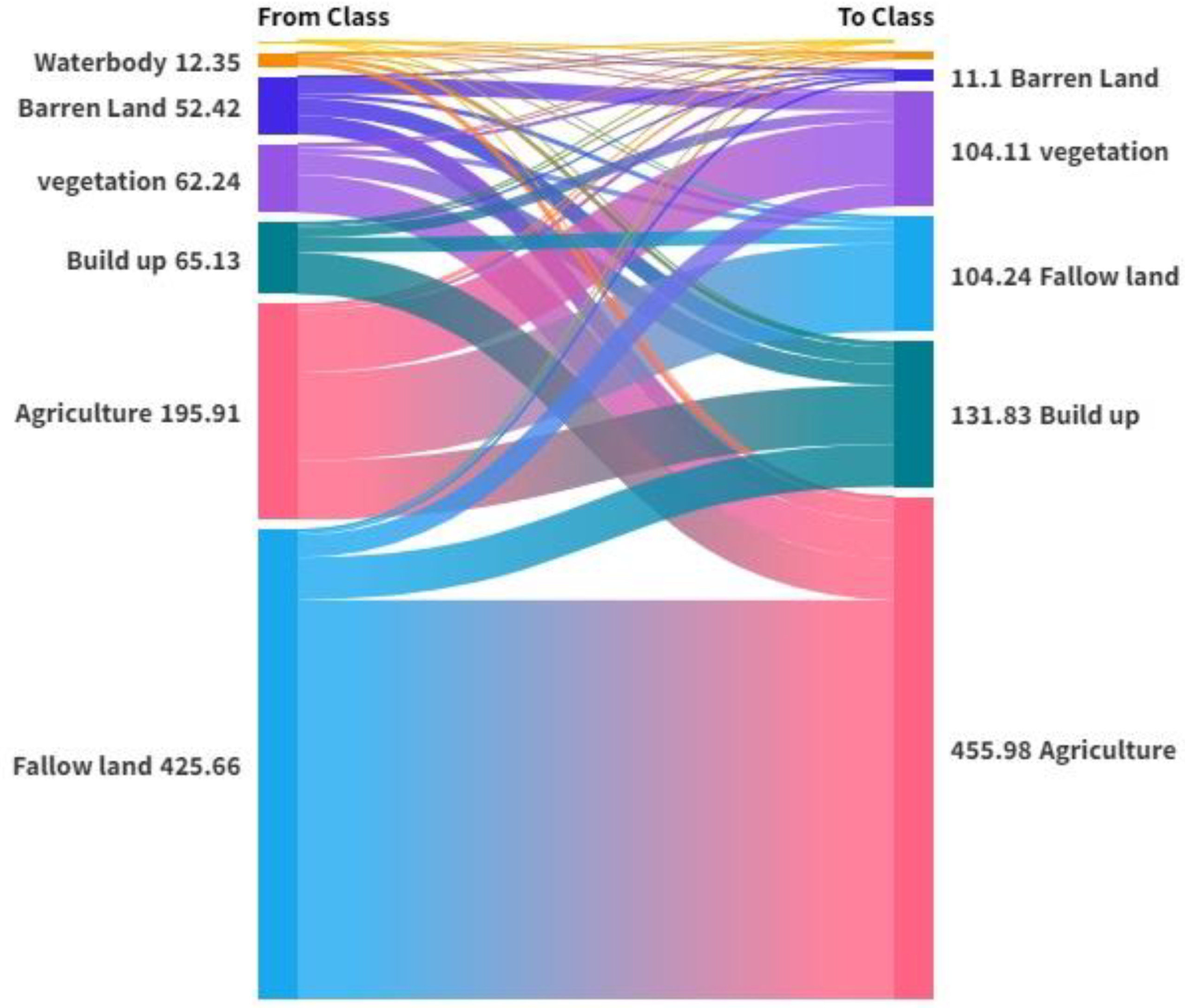
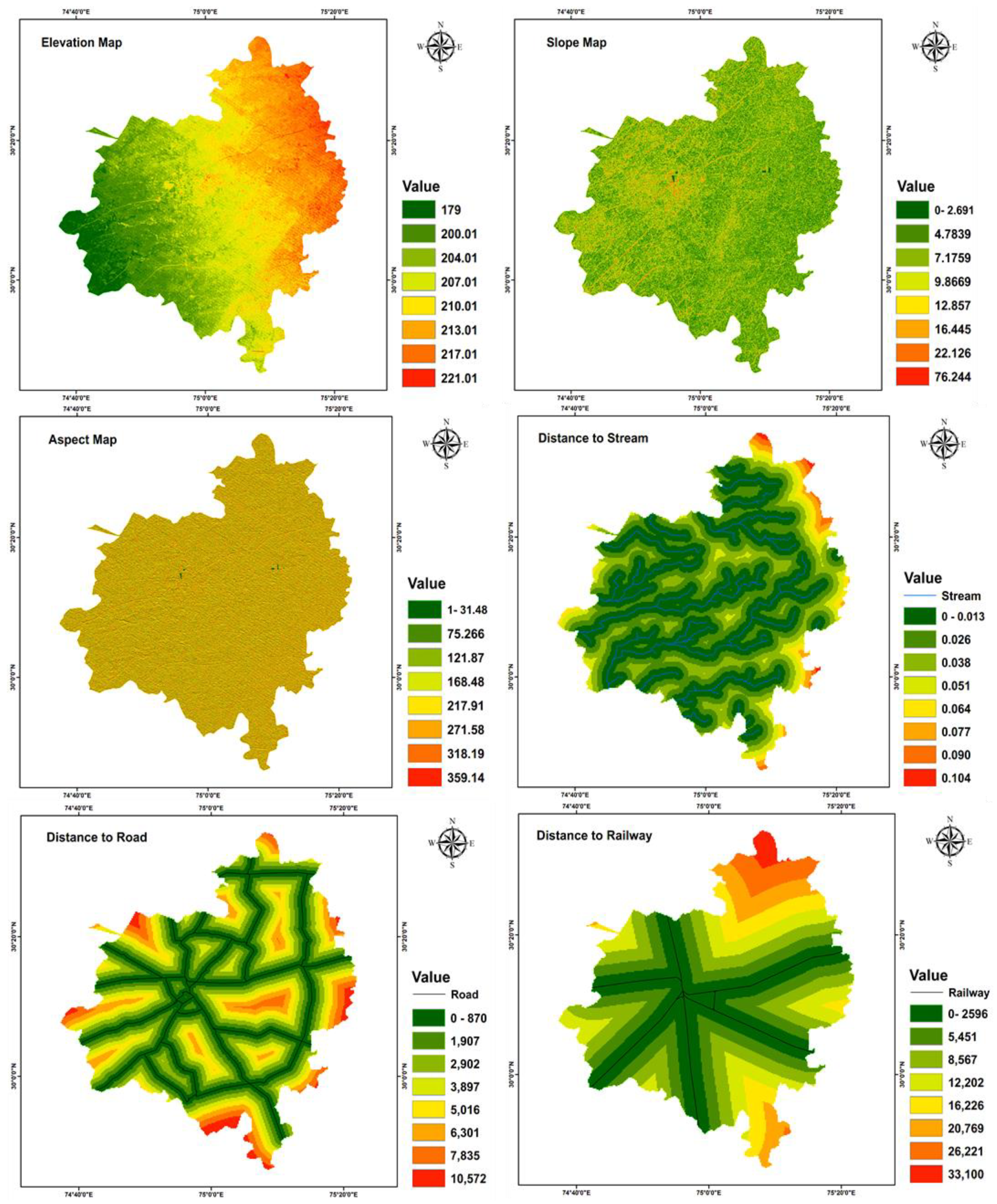
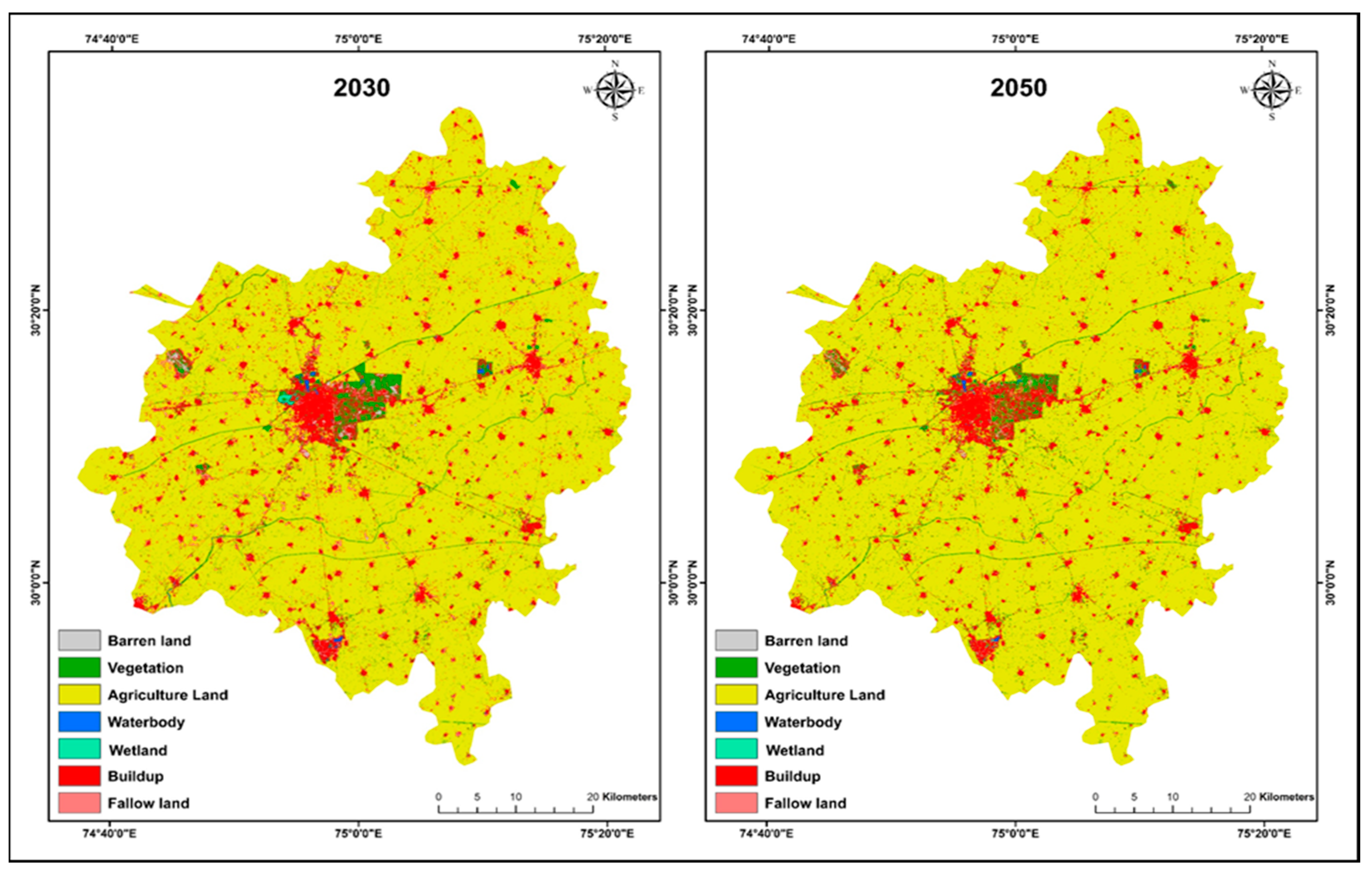

| Aspect | CA–Markov Methodology | Similar Methodologies |
|---|---|---|
| Advantages | ||
| Spatially Explicit Modeling | Effectively captures how places change and connect. | Shows how places change but might miss some connections. |
| Integration of Remote Sensing and GIS | Uses real-time land data and maps for analysis. | Relies on maps but might not include the latest data. |
| Capturing Historical Patterns | Looks at how places changed before to predict the future. | Might not use past changes, leading to less accurate predictions. |
| Decision-Making Support | Helps with making choices, checking impacts, and watching. | Provides decision-making insights but might not offer long-term projections. |
| Disadvantages | ||
| Complexity | Requires skilled expertise in both cellular automata and Markov modeling. | Some simpler methods might lack the predictive power of CA–Markov. |
| Data Intensiveness | Demands reliable input data, including socio-economic and land cover data. | Simpler models might be less data-intensive but provide less accurate results. |
| Transition Probabilities | Relies on accurate transition probabilities, which can be challenging to estimate. | Some methods might assume equal transition probabilities, leading to oversimplification. |
| Comparison | ||
| Hybrid Model | Mixes cellular automata and Markov chain for details. | Similar methods might lean towards one approach, missing the holistic view of CA–Markov. |
| Spatial-Temporal Dynamics | Accounts for historical patterns and spatial interactions for future projections. | Other methods might not consider both spatial and temporal dynamics comprehensively. |
| Prediction Accuracy | High predictive power due to data integration and complex modeling. | Other methods might provide accurate predictions but lack the complexity of CA–Markov. |
| Data Integration | Incorporates remote sensing, GIS, and socio-economic data for comprehensive modeling. | Similar methods might not effectively integrate multiple data sources. |
| Satellite Data | |||||
|---|---|---|---|---|---|
| Satellite Image | Sensor | Path/Row | Cloud Cover | Spatial Resolution | Acquisition Date |
| Landsat 5 | TM | 148/39 | 0.00 | 30 m | 9 March 1990 |
| Landsat 5 | TM | 148/39 | 0.00 | 30 m | 17 February 2000 |
| Landsat 5 | TM | 148/39 | 0.03 | 30 m | 12 February 2010 |
| Landsat 8 | OLI-TIRS | 148/39 | 0.26 | 30 m, Pan–15 m | 24 February 2020 |
| Software/Package | Purpose |
|---|---|
| ArcGIS 10.5 | Geographic Information System (GIS) for spatial data analysis |
| QGIS 3.2 | Geographic Information System (GIS) with Molusce plugin for CA Markov analysis |
| Google Earth Engine | A platform for geospatial data analysis and visualization |
| Remote Sensing Data | Utilized satellite imagery for land cover and change detection |
| Maximum Likelihood Classifier (MLC) | Employed for land cover classification |
| Support Vector Machine (SVM) | Used for land cover classification and analysis |
| Cellular Automaton–Markov Model | Framework for simulating and predicting land use changes |
| Multi-Criteria Decision-Making | Applied for land suitability analysis |
| Python | Calculating F1 Score and Significant Issue |
| Variables Map Data | |||
|---|---|---|---|
| Data | Source | Map | |
| 1 | Road Layer | Open Street Map | Distance to Road |
| 2 | Railway layer | Diva GIS | Distance to Railway |
| 3 | DEM ASTER | NASA Earth Data | Distance to Stream |
| 4 | DEM SRTM | NASA Earth Data | Slope Map |
| 5 | DEM SRTM | NASA Earth Data | Aspect Map |
| 6 | DEM SRTM | NASA Earth Data | Elevation Map |
| Reference Data | ||||||||
|---|---|---|---|---|---|---|---|---|
| 1990 LULC | 2000 LULC | 2010 LULC | 2020 LULC | |||||
| LULC Classes | User Accuracy (%) | Producer Accuracy (%) | User Accuracy (%) | Producer Accuracy (%) | User Accuracy (%) | Producer Accuracy (%) | User Accuracy (%) | Producer Accuracy (%) |
| Barren land | 80 | 80 | 70 | 78 | 70 | 63 | 80 | 80 |
| Vegetation, class | 60 | 60 | 60 | 50 | 70 | 78 | 60 | 67 |
| Agriculture | 83 | 83 | 86 | 82 | 76 | 88 | 84 | 75 |
| Waterbody | 60 | 100 | 80 | 89 | 90 | 90 | 100 | 100 |
| Wetland | 60 | 75 | 40 | 100 | 40 | 100 | 90 | 100 |
| build-up area | 90 | 65 | 80 | 100 | 70 | 39 | 80 | 100 |
| Fallow land | 77 | 67 | 80 | 50 | 70 | 54 | 80 | 73 |
| Kappa index | 0.69 | 0.68 | 0.64 | 0.78 | ||||
| Overall Accuracy | 75.5% | 75.2% | 71% | 82.3% | ||||
| Reference Data | ||||||||
|---|---|---|---|---|---|---|---|---|
| 1990 LULC | 2000 LULC | 2010 LULC | 2020 LULC | |||||
| LULC Classes | User Accuracy (%) | Producer Accuracy (%) | User Accuracy (%) | Producer Accuracy (%) | User Accuracy (%) | Producer Accuracy (%) | User Accuracy (%) | Producer Accuracy (%) |
| Vegetation | 80 | 89 | 90 | 100 | 90 | 100 | 100 | 83 |
| Agriculture | 90 | 100 | 100 | 100 | 100 | 83 | 90 | 100 |
| Waterbody | 92 | 81 | 92 | 92 | 92 | 96 | 95 | 95 |
| Wetland | 80 | 100 | 90 | 100 | 100 | 100 | 100 | 100 |
| build-up area | 100 | 100 | 90 | 100 | 70 | 100 | 90 | 90 |
| Fallow land | 80 | 100 | 80 | 73 | 90 | 75 | 70 | 100 |
| Kappa | 90 | 75 | 90 | 75 | 90 | 82 | 100 | 83 |
| index | 0.85 | 0.88 | 0.88 | 0.91 | ||||
| Overall | 88.5% | 91% | 91% | 93% | ||||
| Class Label | F1 Score (MLC) | F1 Score (SVM) | Significant Issue (MLC) | Significant Issue (MLC) |
|---|---|---|---|---|
| Barren land | 0.8000 | 0.9071 | No | No |
| Vegetation | 0.6331 | 0.9474 | Yes | No |
| Agriculture | 0.7925 | 0.9500 | No | No |
| Waterbody | 1.0000 | 1.0000 | No | No |
| Wetland | 0.9474 | 0.9000 | No | No |
| Build-up area | 0.8889 | 0.8235 | No | No |
| Fallow land | 0.7634 | 0.9071 | No | No |
| Changes LULC 1990 to 2020 | ||||||||
|---|---|---|---|---|---|---|---|---|
| Classs Name | LULC 1990 Area | LULC 2000 Area | LULC 2010 Area | LULC 2020 Area | ||||
| Km2 | % | Km2 | % | Km2 | % | Km2 | % | |
| Barren land | 55.2 | 1.63 | 45 | 1.32 | 32.5 | 0.96 | 17.7 | 0.52 |
| Vegetation | 81.3 | 2.40 | 91.4 | 2.7 | 93 | 2.7 | 123.2 | 3.6 |
| Agriculture | 2597.4 | 76.7 | 2872.1 | 84.8 | 2886.6 | 85.2 | 2859.6 | 84.4 |
| Waterbody | 13.4 | 0.39 | 11.4 | 0.33 | 9.8 | 0.28 | 8.1 | 0.23 |
| Wetland | 2.9 | 0.08 | 5.2 | 0.15 | 5 | 0.14 | 2.3 | 0.06 |
| Build up | 136.4 | 4.0 | 155.8 | 4.6 | 170.3 | 5 | 203.2 | 6.0 |
| Fallow land | 498.2 | 14.7 | 204 | 6.0 | 187.6 | 5.5 | 171 | 5 |
| LULC Classes | LULC 2030 Predicted Area | LULC 2050 Predicted Area | |||
|---|---|---|---|---|---|
| Km2 | % | Km2 | % | ||
| 1 | Barren land | 15.8 | 0.46 | 11.3 | 0.33 |
| 2 | Vegetation | 132.2 | 3.90 | 158.5 | 4.6 |
| 3 | Agriculture | 2870.3 | 84.7 | 2898.4 | 85.6 |
| 4 | Waterbody | 7.7 | 0.22 | 5.6 | 0.16 |
| 5 | Wetland | 2.1 | 0.06 | 0.68 | 0.02 |
| 6 | Build up | 215.5 | 6.56 | 235.3 | 6.95 |
| 7 | Fallow land | 141 | 4.1 | 74.3 | 2.19 |
Disclaimer/Publisher’s Note: The statements, opinions and data contained in all publications are solely those of the individual author(s) and contributor(s) and not of MDPI and/or the editor(s). MDPI and/or the editor(s) disclaim responsibility for any injury to people or property resulting from any ideas, methods, instructions or products referred to in the content. |
© 2023 by the authors. Licensee MDPI, Basel, Switzerland. This article is an open access article distributed under the terms and conditions of the Creative Commons Attribution (CC BY) license (https://creativecommons.org/licenses/by/4.0/).
Share and Cite
Rani, A.; Gupta, S.K.; Singh, S.K.; Meraj, G.; Kumar, P.; Kanga, S.; Đurin, B.; Dogančić, D. Predicting Future Land Use Utilizing Economic and Land Surface Parameters with ANN and Markov Chain Models. Earth 2023, 4, 728-751. https://doi.org/10.3390/earth4030039
Rani A, Gupta SK, Singh SK, Meraj G, Kumar P, Kanga S, Đurin B, Dogančić D. Predicting Future Land Use Utilizing Economic and Land Surface Parameters with ANN and Markov Chain Models. Earth. 2023; 4(3):728-751. https://doi.org/10.3390/earth4030039
Chicago/Turabian StyleRani, Ankush, Saurabh Kumar Gupta, Suraj Kumar Singh, Gowhar Meraj, Pankaj Kumar, Shruti Kanga, Bojan Đurin, and Dragana Dogančić. 2023. "Predicting Future Land Use Utilizing Economic and Land Surface Parameters with ANN and Markov Chain Models" Earth 4, no. 3: 728-751. https://doi.org/10.3390/earth4030039












